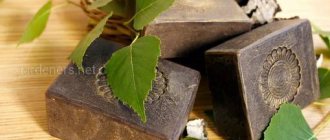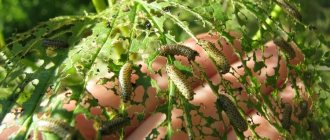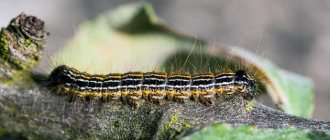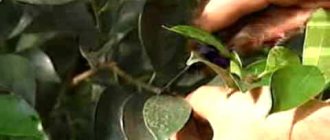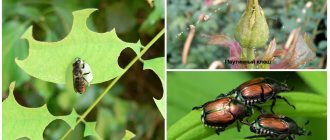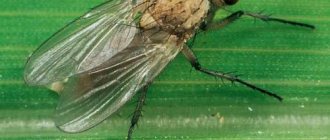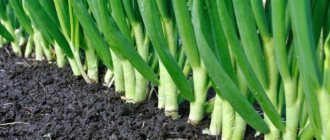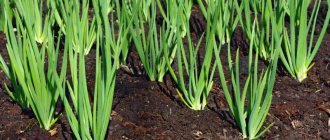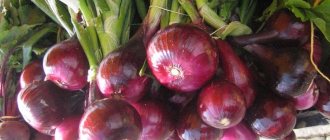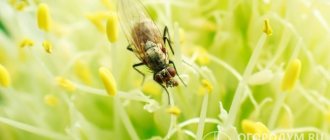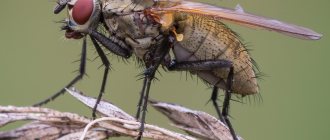Root mite
Symptoms
It happens that when harvesting the grown crop, soft bulbs come across. This is a symptom of root mite infestation, which affects many bulbous plants, including onions and garlic.
The tick lives in soil rich in organic matter and loves rotting remains of vegetation and last year's leaves. Survives well in any conditions, loves moist places. It and the larvae of the onion mite infect the roots of the bulbs and penetrate inside through the bottom. The bulb gets sick, becomes soft and eventually becomes covered with unsightly, loose, dark-colored dust. If you notice such a bulb while storing onions, you must immediately sort through the entire crop and warm and dry the surviving onions at a temperature of about 40 °C.
Treatment and prevention
To avoid such phenomena, you need to follow simple rules:
- Maintain crop rotation, an important condition for all crops. Experienced gardeners never neglect this rule. The best predecessors for onions are: radishes, cabbage, tomatoes.
- Inspecting onions before planting.
- Disinfection of planting material in a solution of colloidal sulfur.
It’s easy to prepare the solution: add 80 g of sulfur to 10 liters of water at 37–40 °C, stir and pour onion sets into the solution for 20 minutes. And drop him off immediately.
- During the growth of onions, for prevention, water with a decoction of chamomile.
Advice! To make a chamomile decoction, you can simply pour boiling water over it in the proportion of 200 g of dry herb per 10 liters of water. Let it brew for 12 hours and water the plantings. Chamomile grows in large quantities in the fields; collect and dry it; it repels many pests and is safe for humans and bees.
- After harvesting and drying the onions, it is recommended to trim off the dried leaves.
- To store onions better, they are heated (fried) for 24 hours at a temperature of 35 °C.
- Chalk helps during storage. If you sprinkle it on the bulbs during storage, the root mite dies; it is afraid of dryness.
Conclusion! When storing onions, they need a completely dry place.
Diseases characteristic of onions
Diseases affect onions both during the active growing season and during storage. Prevention should never be neglected. After all, while fungal diseases can still be dealt with, at the moment there are simply no remedies against bacteria and viruses.
Powdery mildew
Almost all garden crops suffer from this pathogenic fungus, onions are no exception. Most often, the pathogen is transmitted through seeds. If you do nothing, you can lose at least half of the harvest. Factors favorable to infection are dense plantings, shaded beds, waterlogged soil, and frequent rains.
Powdery mildew is one of the most common diseases in the garden.
The first symptoms appear already in April-May. The leaves become covered with greenish-yellow spots, gradually acquiring a grayish-purple tint and becoming covered with a layer of powdery whitish coating, reminiscent of spilled flour. These spots are especially noticeable in the early morning, when the dew has not yet dried. The plaque gradually changes color to pinkish-brown and thickens. The leaves become fragile, droop, and the bulbs stop growing. There are varieties with increased resistance to fungus - Stimul, Antey, Kasatik, Centurion, Stuttgarten Riesen.
There are no onion varieties with “innate” immunity to powdery mildew, but there are varieties that resist the fungus more successfully than others
To prevent infection, seeds and onion heads must be kept in hot (40–42ºС) water or a bright pink solution of potassium permanganate for 6–8 hours before planting. Then for 15–20 minutes they are immersed in a biofungicide solution (Baktofit, Polyram, Fitolavin, Alirin-B).
After harvesting, the bed is loosened (it’s better to dig it up) and all plant debris is carefully collected. Crop rotation is also very important - onions are planted in the same area for a maximum of 3-4 years in a row, then a break of the same length is required. It is not advisable to plant it after parsley, beets, garlic, flowers from the Liliaceae and Iris families.
Each time you loosen a bed, it is useful to scatter crushed chalk and sifted wood ash over its surface, and add a little potassium permanganate (2–3 g per 10 liters) to the water for irrigation at least once every 10–15 days. A folk remedy for prevention is diluted sour kefir or whey with the addition of a few drops of iodine. In autumn, the soil is watered with Horus or Oksikhom solution.
Having detected suspicious signs, the water rate for irrigation is reduced to the required minimum, and nitrogen-containing fertilizers and natural organic matter are stopped. Excess nitrogen in the soil negatively affects the plant’s immunity, and fungal spores overwinter well in manure.
Onions and beds are treated with a solution of Polycarbacin, Quadris, Topaz, Skor. Old proven remedies also help well - 1% copper sulfate and Bordeaux mixture, but they cannot be used when onions are grown for feathers. If, after treating with the last two products, the feathers acquire a bluish tint, this is normal. Spraying is carried out 2-3 times with an interval of 7-12 days. It is useful to add liquid or grated soap (20–25 g per 10 l) or a couple of drops of glycerin to any solution - this way the compositions “stick” to the leaves better and the effect lasts longer.
Video: fighting powdery mildew in the garden
Downy mildew (downy mildew)
Onion leaves become covered with straw-yellow spots; as the disease develops, they acquire a smoky lilac hue. Feathers wither, become brittle, dry out and turn black. The fungus develops most quickly in cool, rainy weather. Other factors favorable to it are a lack of light and fresh air. The disease also affects the bulbs - they shrink and rot. The shelf life of the harvested crop is sharply reduced. If the summer is hot and dry, fungal infection is practically excluded. But the spores remain in the soil until the next season.
Infection of a plant with peronosporosis has a very negative effect on the keeping quality of the bulbs.
There are no varieties that are completely resistant to downy mildew, but Christina, Ellan, Odintsovets, Farmer, Oporto, and Stuttgarter Riesen suffer from it much less frequently. The same applies to interspecific hybrids (Sigma, Emerald, Golden Domes). Due to the discrepancy between development cycles, infection of early onions is practically excluded.
Preventive measures are the same as those used to prevent the development of powdery mildew. An infusion of nettle leaves, dandelion leaves, and any garden weeds in general also gives a good effect. It is also a comprehensive natural supplement. To combat downy mildew, Ridomil-Gold, Thanos, Abiga-Pik, and Poliram are used.
Nettle infusion is not only a complex natural fertilizer, but also an effective prevention of peronosporosis
Rust
The appearance of characteristic symptoms is observed only on the leaves. They become covered with pinkish-red “swellings”, and at the same time spots of bright saffron-yellow color with a fleecy surface appear. Gradually they thicken, the shade changes to terracotta orange and rusty brown, then turn black. The pathogen is transmitted in the vast majority of cases through the soil; fungal spores are characterized by very high frost resistance.
Rust in the garden mainly affects fruit trees and berry bushes, but onions can also suffer from it
For prevention, seeds and heads must be warmed before planting. The soil is shed 2–3 weeks before planting and after harvesting with a deep pink solution of potassium permanganate, 3% copper sulfate or Bordeaux mixture, Nitrafen. To combat rust, the most common fungicides are used (HOM, Kaptan, Zineb).
Potassium permanganate solution is one of the most common disinfectants; it helps destroy fungal pathogens
Aspargillosis (black rot)
Affects bulbs during storage. Most often, those that suffer from fungus are those that were not dried before placing them in the basement, cellar, or other suitable place. Onions harvested unripe are also in the high-risk area. Failure to comply with storage conditions also contributes to the development of the disease - high temperatures and lack of ventilation favor the fungus.
The affected bulbs soften, the neck becomes discolored, and the scales at the top dry out. A fine black powder forms between them. In fact, it is a solid mass of fungal spores.
Onion aspargillosis develops due to non-compliance with storage conditions and improper preparation for it.
For prevention, 20–25 days before harvesting, the onions and soil in the garden are treated with a 1% solution of Bordeaux mixture or copper oxychloride. The storage must be disinfected by wiping racks, shelves and any surfaces in general with a solution of slaked lime. Or you can burn a piece of sulfur bomb inside with the doors tightly closed.
A sulfur bomb helps to quickly disinfect a basement, cellar, or other storage
Before storing the bulbs, they are powdered with crushed chalk, wood ash, and colloidal sulfur. Particular care must be taken in the area where the leaves are cut. During the winter, onions are regularly inspected; specimens with suspicious signs are immediately discarded.
Video: how to properly store onions to avoid the development of rot
Gray cervical rot
Only bulbs that have already been harvested from the garden also suffer from this disease. Symptoms appear fairly quickly, during the first month of storage. It spreads, as the name suggests, from the neck. The outer scales dry and wrinkle, those underneath are covered with a layer of grayish plaque with small black inclusions. When cut, they are at first translucent (like a boiled onion), then turn brown. As the disease develops, the plaque moves down to the bottom in spots, the bulb becomes loose, and the tissue on the cut becomes pinkish.
Bulbs affected by gray rot are no longer suitable for food
The causative agent of the disease most often penetrates through mechanical damage, for example, during pruning of leaves. To avoid this, dip a knife or scissors into a deep purple solution of potassium permanganate after each cut is made. If you don’t clear the bed, it will overwinter well in plant debris. Most often, bulbs with a fleshy neck, harvested ahead of schedule, and those that are not sufficiently dried, suffer from gray rot.
Drying onions before storing is an effective prevention of gray rot of the neck
To minimize the risk of infection, the bulbs are dried for 9–10 days after harvesting in a room where the temperature is maintained at 28–33ºС and there is good ventilation. Equally important is compliance with storage conditions - air humidity 70–75% and temperature 1–3ºС. Before planting, the heads are etched in a TMTD or Thiram solution for 10–15 minutes. 7–10 days before harvesting, the bed is treated with a solution of Quadris, Bravo, Switch.
Fusarium (bottom rot)
When infected with fusarium, feathers turn yellow and dry out starting from the tips. The bulbs stop growing, and a layer of pinkish plaque, reminiscent of mold, forms at the neck. The roots and bottom turn black, become slimy to the touch, and give off an unpleasant putrid odor. When cut, the scales turn brown and mucus oozes from them. The most suitable microclimate for the development of fungus is heat and low humidity. It spreads through water, substrate, plant debris, and wind. Crop losses, if the fungus is not controlled, can be very significant - 70% or more.
The causative agent of fusarium penetrates the bulb through the roots, and they are the first to suffer
Fusarium can also affect onions stored for storage. In such specimens, the bottom softens, becomes translucent, and becomes covered with a layer of pinkish-yellow coating. Small pink “pads” form between the scales. Then the bulbs dry out, practically mummifying.
Fusarium-affected onions seem to wilt and dry out for no reason.
Treatment of the disease is complicated by the fact that it is impossible to detect it at the beginning of its development. Typical signs that make it possible to accurately verify the presence of fusarium appear when the disease has already gone far, the process is irreversible. For prevention, bulbs intended for planting must be pickled in a solution of Fundazol or Quadris. Regular water for irrigation is replaced every 1.5–2 weeks with a solution of any biofungicide (Maxim, Vitaros, Trichodermin, Previkur), reducing the concentration by half compared to that recommended by the manufacturer. Among folk remedies, you can use those that provide the prevention of powdery mildew. In autumn, the soil in the garden bed is watered with Ridomil-Gold and Acrobat-MC.
Fusarium can be distinguished from ordinary wilting due to too little watering by cutting off a few feathers or the entire plume. A fungal disease is characterized by the presence of small brown inclusions in the tissues - clogged blood vessels.
Video: combating fusarium blight on onions and garlic
Mosaic disease
A viral disease that, of course, will not kill onions, but will reduce the yield by 15–20%. Affected bulbs are edible; seeds, in principle, can be planted, but germination rate will be much lower than usual.
Onion feathers affected by mosaic disease turn into something resembling waves
Infected specimens are severely stunted in growth, feathers lie down, and flower stalks are deformed. The flowers become unnaturally larger and the petals grow together. Often small bulbs form in their place. The leaves become almost flat, a pattern of chaotically located small yellowish-white spots, specks, strokes, and, less often, concentric circles appears on them. The bulbs stretch in length.
To prevent the development of mosaic disease, it is necessary to specifically combat its carriers
There are currently no drugs developed for the treatment of mosaic. However, the virus is known to be transmitted by aphids, mites and nematodes. It is transmitted from diseased plants to healthy ones through sap and is stored in the bulbs.
The best prevention is proper agricultural technology (especially in the area of watering), regular weeding of the beds, avoidance of dense plantings and crop rotation. We must not forget about the targeted fight against virus carriers.
Jaundice
Another viral disease that cannot be cured. The leaves and arrows turn yellow completely starting from the tips. The bulbs stop growing and no seeds are formed. For prevention, the same measures are used as for mosaics.
In plants affected by jaundice, the bulbs are deformed, do not reach the typical size for the variety, and are almost not stored
Stemphylliosis
Many agronomists consider it not an independent disease, but a secondary one, since most often bulbs that are already affected, for example, by downy mildew or Alternaria blight, suffer from stemphylliosis, especially if the weather is dry and warm outside. The disease develops towards the end of the growing season. Its pathogen successfully overwinters in plant debris and remains viable on bulbs throughout the entire storage period.
Onion stemphylliosis most often affects plants already weakened by some disease.
The leaves are covered with small yellowish-beige spots, gradually turning into elongated bulges filled with a cloudy viscous liquid. Then a darker border forms along the edge, and the surface is covered with a layer of black-brown plaque. The leaves turn yellow and break easily. The first to be affected are those that are already drying out and dying.
For prevention, the bed and the onion itself are treated once every 2-3 weeks with a solution of Acrobat-MC, Aliette, Quadris, Fandango. Folk remedies that prevent the development of peronosporosis and powdery mildew are also suitable. No special means have been developed to combat the disease, so it is better to simply remove the affected specimens from the garden bed and burn them, and disinfect the soil in this place by sprinkling it with a dark crimson solution of potassium permanganate or 3% copper sulfate.
Green moldy rot
It affects bulbs put away for storage if they received mechanical damage during the harvesting process or were frozen. “Wet” pale yellow spots appear on the surface of the scales, gradually changing color to blue-green and becoming covered with mold. When cut, the tissue contains visible inclusions of a greenish-brown hue. They soften from the inside, but the outside of the bulb remains hard. At the neck, the scales dry out, and a fine bluish powder, similar to dust, forms under them. Prevention of this disease is exactly the same as for other onion diseases that develop during storage.
To prevent the development of green moldy rot, it is very important to create optimal or close to optimal conditions for storing onions
Onion hoverfly
Symptoms
The hoverfly is very similar to the onion fly, only it is slightly darker and larger in size. The hoverfly begins to fly a little later than the onion fly, somewhere in late June, early July, laying eggs between dry onion scales near the ground, 6–10 eggs at a time. They can lay eggs directly in the ground next to the onion head. Two generations of this pest appear per season. Usually, they choose already affected and diseased bulbs.
The larvae actively develop inside, which is why the bulbs rot very quickly, the feather withers and turns yellow, and the bulb dies.
Treatment and prevention
Prevention is the main weapon in gardening.
- Treat onion sets in a solution of potassium permanganate against diseases and viruses, the onion will be strong and healthy.
- Crop rotation must be observed!
- Autumn cleaning of beds from debris and the remains of any root crops.
- Plant carrots next to the onions, which repel flies well.
- Loosening the soil near the plantings, which will prevent the development of larvae from laid eggs.
- Sprinkle onion plantings with dry ash, tobacco, hot pepper or mothballs once a week.
- The harvested onions should be properly dried before storage.
Advice! The ideal weather for drying onions is dry, sunny and windy. Spread the onion in the air in a thin layer and stir it constantly so that the onions dry evenly on all sides.
You can't leave it overnight! Put it under the canopy until evening. Repeat drying for a week.
After harvesting the onion, if diseased and damaged plants are noticed, spill the soil with copper sulfate.
If you cannot do without chemicals, then it is permissible to use the drug “bazudin”, but do not forget that it is poison! It is better not to use feathers from such a bed later.
Prevention measures
It is much easier to prevent the appearance of pests than to fight them.
Therefore, after harvesting and in preparation for sowing onions in the spring, attention should be paid to measures aimed at preventing the appearance of insects on the site
Important! It is recommended to plant onions in the garden as early as possible so that the plant has time to get stronger by the time pests appear.
Let's consider the main preventive measures:
- The harvested onion crop should be stored in a dry room at an air temperature no higher than +9°C and humidity up to 60%;
- before storing the harvest, it is thoroughly dried and inspected, removing damaged bulbs;
- the room intended for storing onions is disinfected with sulfur gas;
- before storing the bulbs, sprinkle them with chalk to stop the development of pests hidden on the tubers;
- compliance with crop rotation - onions cannot be planted in the same area for two years in a row;
- disinfecting the soil with a solution of copper sulfate before planting onions;
- before planting the bulbs, they need to be treated with a solution prepared from 40 g of colloidal sulfur and 10 liters of water;
- destruction of all plant residues after harvesting;
- deep autumn plowing of the soil on the site to destroy pests in the upper layers of the soil;
- maintaining the recommended distance between plants during planting to avoid crowding of the beds.
Onion fly
Symptoms
If you suddenly notice yellowed tips of feathers, drooping arrows or curling of onions while planting onions, it means that the onion fly, the most common pest, has settled in the beds.
The onion fly is similar to a regular fly, only it is gray in color and 1 cm long. When the lilac blooms, the fly begins to actively fly and look for a place to lay eggs. The best place for this is dry onion scales at the very base. The larvae bite into the bulbs and “gobble up” the juicy pulp for three weeks, eating through extensive passages.
The leaves of the plant wither, turn yellow and then dry out completely, and the bulb emits an unpleasant odor. The larvae go into the ground, where by July they turn into flies, fly out and damage all crops with renewed vigor. In the southern regions, where onions are grown in large quantities, three generations of flies grow per season.
Treatment and prevention
If you have already observed onion infestation with a fly, then most likely the soil is already contaminated with pupae of this pest. Therefore, digging up the soil in early spring will give a good result: the pupae will be exposed to cold air and most of them will disappear.
What other means are there?
A good proven drug “Zemlin”, which fights many soil-dwelling pests. It is simply scattered on the surface of the soil. It has long been known that the onion fly avoids laying eggs in carrot plantings, so this fact must be used.
Advice! Plant two crops close to each other, at the optimal distance, not forgetting that as they grow, carrots become spreading. Good experience: line method, alternating onions and carrots.
When planting, you can reduce the likelihood of a fly laying eggs in onion scales by deepening the set by 3 cm during planting, hiding the neck in the ground.
Traditional methods of struggle:
- From the moment the feather grows 3–5 cm, watering with a saline solution is used: 200 g of salt per 10 liters of water, watering once every 10 days.
- Ammonia solution: 3 tablespoons per 10 liters of water.
Water so that the solutions do not get on the leaves! If you find damaged bulbs, remove them mercilessly!
Chemical insecticides for pest control of onions and garlic
| Name of insecticide | Pest against which treatment is carried out | Consumption rate of the drug (kg/ha, l/ha) | Packaging |
| Aktara 25 WG, v.g. (thiamethoxam, 250 g/l) | Onion fly, tobacco thrips, onion secretive proboscis, hoverfly, leaf beetle (rattler) | 0,2-0,4 | 1.4 g, 6 g, 250 g |
| Apollo c.s. (clofentizine, 500 g/l) | Onion mite | 0,3-0,5 | 1 l, 5 l |
| Bi-58 new, k.e. (dimethoate, 400 g/l) | Ticks, thrips | 0,5-1,0 | 1 l, 5 l, 10 l |
| Vertimek 018 EC k.e. (abamectin, 18 g/l) | Thrips, spider mite | 0,8-1,2 | 10 ml, 100 ml, 1 l |
| Decis f-lux 25 EU, k.e. (deltamethrin, 25 g/kg) | Thrips, onion fly, onion hoverfly, onion muskellunge | 0,2-0,3 | 5 l |
| Exirel, S.E. (cyantranilprole, 100 g/l) | Thrips, onion fly | 0,75-1,0 | 250 ml, 1 l |
| Enzhio 247 SC, k.s. (lambda-cyhalothrin, 160 g/l + thiamethoxam, 141 g/l) | Onion fly, thrips | 0,18 | 3.6 ml, 100 ml, 5 l |
| Karate Zeon 050 EU, k.e. (lambda-cyhalotron, 50 g/l) | Onion fly | 0,15-0,4 | 5 l |
| Pirinex Super, k.e. (chlorpyrifos, 400 g/l + bifenthrin, 20 g/l) | Onion root mite | 0,8 | 1 l, 5 l |
| Movento k.s. (spirotetramat, 100 g/l) | Thrips | 0,75-1,0 | 1 l |
| Mospilan, v.p. (acetamiprid, 200 g/kg) | Onion cracker | 0,2-0,3 | 50 g, 0.2 kg, 0.4 kg, 1 kg |
| Commander, r.k. (imidacloprid, 200 g/l) | Onion cracker, thrips | 0,1 | 1 l |
| Lannat v.r. (methomyl, 200 g/l) | Tobacco onion thrips | 0,8-1,2 | 1 l, 5 l |
| Nissan, sp. (hexythiazox, 100 g/kg) | Onion root mite | 0,4-0,5 | 0.5 kg |
| Nurel D, Ph.D. (chlorpyrifos, 500 g/l+cypenrmethrin, 50 g/l) | Thrips, onion fly | 0,8-1,2 | 7 ml, 5 l |
| Ratibor, v.r.k. (imidacloprid, 200 g/l) | Onion fly | 0,25-0,3 | 4 ml, 10 ml |
| Fastak, Ph.D. (alpha-cypermethrin, 100 g/l) | Onion moth, onion thrips | 0,1-0,15 | 1 l |
If you find an error, please select a piece of text and press Ctrl+Enter.
Onion moth
Symptoms
Onion moths are ubiquitous and love warm, dry weather. It is at this time that its activity increases. Moth larvae are about 11 mm long, very voracious, they eat away the feather from the inside, leaving the outside intact.
The leaves begin to quickly turn yellow at the end, and then dry out completely. You can see a damaged feather immediately: it will have longitudinal, uneven light stripes.
The moth begins to fly quite early, back in April and May, at night, laying 50–75 eggs! And after a week, caterpillars appear and live for about two weeks, then turning into pupae right on the onion leaves or on the weeds. Within two to three weeks a new generation appears. The horror is that three generations are formed in the middle zone during the season!
Treatment and prevention
Treatment and prevention lies in proper care of the beds, and then the plantings.
- Mandatory deep digging of the earth in autumn and early spring.
- Cleaning up all residues from the beds, burning sick and pest-damaged plants.
- Crop rotation helps eliminate many problems with pests and diseases, and this gives a significant increase in yield.
Advice! Crop rotation is a whole science. Once you figure it out, it will be easy to understand what to plant after the previous crop. Garlic will feel great after potatoes, cucumbers, squash, zucchini, pumpkin, peas or beans. The soil can become healthier after sowing green manure, which includes: oats, barley, rye, vetch, mustard, amaranth, buckwheat and beans.
- Control weeds throughout the season.
- Preventive watering with folk remedies for pests. A solution of ammonia has proven itself well: 3 tbsp. spoons per 10 liters of water, as well as infusions of herbs such as tansy, wormwood, red pepper and tomato tops.
- If you find more than two caterpillars on one onion, then immediately apply some kind of insecticide. But after this treatment, do not eat the feather!
Description
The causative agent of peronosporosis is a typical obligate parasitic fungus. It leads to onion disease and reduced yield. The mycelium of the fungus has wintering (dormant) and summer (vegetative) forms. The source of infection during the initial growing season is the plants grown from the affected bulbs. Planting diseased specimens poses the greatest danger - after two/three weeks, a conidial coating forms on the onion leaves, after which the plants begin to die.
In addition to bulbs, fungal spores can overwinter in plant debris, germinating under conditions unfavorable for the fungus. Bulgarian scientists have found that one diseased specimen infects 90% of plants within a radius of 2 meters, and 30-35% of plants within a radius of 6 meters. Phenomenal: in just four incubation periods (1 period is 11-15 days), a single outbreak can spread 2 kilometers!
Downy mildew also causes losses in onion storage areas. Scientists' experiments have shown that affected bulbs are poorly stored and germinate prematurely, and losses reach 50-60%.
Onion weevil
The onion weevil or secretive proboscis is the enemy of all bulbous plants. He did not ignore onions, which belong to the onion family.
Symptoms
The weevil can eat the entire plant, but more often it gets by with the green part, so it can be found on the surface. And if you see this pest, then immediately start fighting it.
May be interesting Planting days for onions Exhibition for 2021 according to the lunar calendar Diseases and pests of cucumbers that provoke stem damage Potato nematode: description of the disease, how to fight, prevention
The beetle lays eggs invisible to the eye, from which larvae emerge, eating the green mass so that you can be left without a feather. And if there is no feather, the bulb will not ripen and will not be stored well.
In addition, the larvae eat the flower stalks, preventing seeds from forming. The beetle produces two offspring per season. Leaves damaged by larvae become striped, turn yellow and die.
The beetle lives in the upper layers of the soil and rises out in the spring. Perhaps you have observed how farms release chickens into the garden in early spring? This is the best way to control pests: chickens eat both beetles and larvae in the ground.
Advice! In winter, feed the birds on your site: sparrows, tits, and in the spring they will help you with pests.
Treatment and prevention
- Crop rotation. Following it will save you from most problems. Diseases and pests of onions may disappear or be reduced several times.
- Preparing the soil: digging to a depth of at least 20–25 cm in autumn and early spring so that the larvae and beetles living in it die from frost.
- They set traps for the beetle. Affordable, but labor-intensive: cut the packaging cardboard into strips, wrap the strip around each plant, secure it so that it does not straighten out.
- Frequent loosening of the soil around plants, this action destroys the “pupae”.
- Treat with dry ash and tobacco.
- If there is an urgent need, treat with “karbofos” or “azadirachtin” once.
Useful tips
In the fight, all means are good. It is better to use the listed methods in combination, but proceed to chemistry only in extreme cases. What else can be done against flying and crawling insects in onion beds:
- The fight should be waged all season long. You can’t dig up the soil in the fall and think that the problem won’t return. All known techniques should be performed as needed and in a timely manner.
- If the pest is already inside the onion, then after baiting the diseased areas should be removed, since the scale insects, having penetrated into the cavity of the feather, will not receive the required dose of poison and will develop further.
- When purchasing onion sets for planting, you should select the bulbs individually, and when you bring them home, inspect the product again and treat it.
- Insect pupae are laid in the soil to a depth of 10 cm, so loosening to this depth should be carried out several times during the season.
Onions are a very porous and juicy vegetable crop, which attracts pests. The rich nutrient substance often perishes due to the negligence of gardeners. Failure to observe crop rotation, poor-quality planting material, and unprepared soil can cause the death of the onion crop.
Thrips
Thrips include several species of insects of the smallest size. These pests multiply very quickly: they produce several generations in open ground and in greenhouses - up to eight generations, laying more than a hundred eggs per season.
Symptoms
These small invaders feed on plant sap, causing suffering to young shoots. As a result, plants lag behind in growth, become deformed and stop developing.
For onions, onion and tobacco thrips, which are difficult to remove, are dangerous.
Bulbs affected by thrips look wrinkled under the scales, and on top they acquire a dark brown color with a silvery tint.
Prevention measures
Controlling pests on onions is very difficult. By damaging the leaves, they thereby create favorable conditions for the penetration of infections. As a result, the gardener may lose the entire crop, including the bulbs.
It is impossible to fight white worms with chemicals, so special attention must be paid to preventive measures: from observing crop rotation to pre-planting treatment of bulbs and seeds. Gardeners who neglect these rules risk serious losses.
Digging beds
Pest larvae develop in the bud, and adult insects also hide there for the winter. Therefore, autumn digging and loosening throughout the season helps prevent the appearance of white worms on onions.
Systematic loosening prevents insects from pupating, which means there will be fewer adult secretive proboscis, and there will be no one to lay eggs in onion greens. As for the onion fly: it does not like loose soil and will not lay eggs in it.
Autumn digging makes insects hidden in the ground easy prey for birds, while surviving individuals will die during frosts.
Crop rotation rules
Crop rotation is a poor defense against the secretive proboscis: the insect rarely overwinters near the garden, preferring secluded places far from humans, which means it will fly to the dacha again in the spring. But crop rotation helps against onion fly. You cannot plant onions in the same place for several years, with the exception of onions, which can grow in one bed for years.
Good results are obtained by planting onions in the beds where carrots were sown last year and vice versa. Using the same principle, it is good to plant carrots and onions side by side; the first plant repels the onion fly, the second - the carrot fly.
Clean garden
It is difficult to fight weeds, especially over a large area, and therefore it is impossible and not necessary to keep the garden perfectly clean. It is much more important to promptly remove and burn plant debris. This is especially true for the technology of growing plants under mulch: it is unacceptable to leave last year’s mulch on the beds; it is changed every 1-2 months.
Bulb processing
Onion sets may already be affected by onion fly eggs, and therefore there is a risk of introducing the pest into your area. It is correct if the material is processed before planting:
- Visual inspection, rejection of damaged specimens.
- Feeling and removing bulbs with a soft bottom.
- Soaking the planting material for 20 minutes in a solution of potassium permanganate, followed by drying.
For preventative purposes, you can soak the bulbs in a tar solution, the recipe is listed above. After this treatment, you don’t have to worry about bringing carrot flies into the beds, and there will be fewer white larvae.
Stem nematode
Stem onion nematode is the most dangerous enemy. She is amazingly resilient. These small worms are capable of hiding in the ground at a depth of up to 1.5 meters and then crawling out to the objects of attack; they are not afraid of frost and can live at a constant temperature of + 2 °C in a vegetable store, continuing to infect bulbs. Without food, nematodes survive for 18 months or go into suspended animation, and can survive up to 20 years, and then continue their activities. The female is capable of laying 400 eggs in her life of 30–40 days.
Symptoms
Stem nematode is a pest of many vegetable crops. It causes serious damage to onions by sucking out the sap of the plant. This pest can live 3–4 years. At first they live on plants, then they go into the ground. Heavy soil and high humidity are the most favorable conditions for this parasite.
The first leaf of the affected plants appears at the beginning of the growing season - the feather is slightly thicker and crooked. Subsequently, the leaves droop and turn yellow. Inside the bulb, the scales soften and rot. The bulb is soft to the touch.
Advice! Such bulbs are unsuitable for consumption and storage! Even if you decide to cut off the darkened scales and use the white ones for cooking, don’t do it!
One such bulb can contain up to several thousand worms! You can only see them through a strong magnifying glass if you cut the onion into 3 mm pieces and fill it with water so that the level is no more than 5 mm for an hour while examining the water.
Treatment and prevention
There is still no remedy that would destroy the stem nematode. And all the products are poisonous, and they need to be processed repeatedly. So it all comes down to prevention.
Healthy planting material is very important in the fight against this infection!
- Proper storage of onions and onion sets.
- Crop rotation. No earlier than four years, plant onions and garlic in the same place.
- Before planting, add urea to the ground or sprinkle with ammonia (3 tablespoons per 10 liters of water).
- Planting time also plays an important role. Onion seeds should be planted or sown as early as possible so that the temperature is lower.
- Cultivate the land. Add sand and peat under the plantings to make the soil as light as possible, which the worm does not like. And it’s good to add dolomite flour or lime when digging, deoxidizing the soil.
- Process planting material. The onion sets need to be carefully sorted, dry scales should be trimmed with scissors, and loose layers should be peeled off.
Advice! You can deoxidize the soil with soda. To do this, dissolve 10 g of soda in a bucket of water and pour over the beds, or pour 100 ml into each hole.
How to treat onions for pests before planting?
Take a container with hot water at 45–47 °C and pour all the seeds into it. While it warms up, and this temperature is harmful for many pests, dilute 1 tablespoon of birch tar in 1 liter of water. For this, also pour warm water. Pour this mixture over the sevok. Leave for 4 hours.
This wonderful product with a strong smell will repel many pests, plus the prevention of fungal diseases. After such a bath, the onions are ready to plant!
Biological drugs
If we are talking about a small private farm, then traditional methods of pest control are best suited for processing the garden. But if the invasion has become widespread, experts know what to do and how to treat the plants.
If traditional methods do not produce results, you can no longer do without biological fungicides
You should choose chemicals carefully and carefully. They must be safe for human health
Trichodermin
At the stage of detecting onion worms, you cannot hesitate. In this case, it is advisable to use the drug Trichodermin. Before use, you should carefully study the instructions and recommendations from the manufacturer on how to get rid of the pest. The solution is prepared in the following proportions: take 3 liters of water per 3 g of substance.
The prepared mixture must be treated with the plants. Watering is not recommended immediately after spraying, so as not to wash off the active product from the feather. After 10 days, the culture is sprayed again. If larvae reappear, additional treatment is necessary.
Metronidazole
This medicine in tablets can be purchased at the pharmacy. The product has antimicrobial and antibacterial effects. Before use, it is worth learning how to properly prepare a solution for processing the garden. The drug is effective against onion flies, nematodes, and a number of similar pests.
Removing insects is sometimes difficult; various antiparasitic methods and control methods are used for these purposes. Metronidazole has proven itself as an effective treatment for various vegetable crops. A solution is prepared for spraying.
Aphid
Many will be surprised that we also list aphids as a pest of onions, because onion peels are often used to control pests. But the fact is that onion aphids exist. It affects onions grown in greenhouses.
Aphids love warm weather; with its onset, they settle in large colonies on plants, drinking the juices from them. During the season, aphids hatch 50 times!
Symptoms
Aphids not only drink juices, but also secrete a specific poison, infect plants with viruses, staining and spoiling the decorative appearance with their vital activity.
The leaves curl and bend, and the young shoots are covered in small gray to green pests.
Treatment and prevention
It is difficult to fight aphids, but it is possible.
- Weed control.
- Aphids are afraid of garlic, white mustard, and marigolds, which can be planted nearby.
- Sprinkling with dry ash.
- Watering with infusion of fermented herbs. To do this, different herbs are infused for a week, then filtered and watered.
- Spray the plants with Coca-Cola. Aphids do not like it and die from the acid contained in the drink.
All these methods make it possible not to harm the greens in order to eat them, but they are precisely preventive.
Important! Do not use poisons! If necessary, use the drug "Verticillin", which is safe for feathers, made on the basis of fungi, which, when sprayed, fall on the aphids, germinate in them, and the aphids die. Treat with this drug once a week.
We looked at the main pests of onions. Now that you have received tips on protecting such a necessary vegetable as onions, its harvests should only please you
Symptoms of pest damage
Pests attack onions both during the growing season and during storage.
Symptoms:
- change in color of green feathers;
- the appearance of spots and stripes on the leaves;
- drying of feathers;
- softness of the bulbs;
- the appearance of plaque on the plant.
Yellowing and drying of feathers are also caused by other reasons. For example, acidified soil, lack of nitrogen, copper or potassium, excess moisture in the soil. If you are sure that the soil is fine and the onions are not sick, then the problem is a pest invasion.
Need to know . Onion pests pose a danger not only to onion beds, but also to related plants: garlic, tulips, daffodils, lilies.
